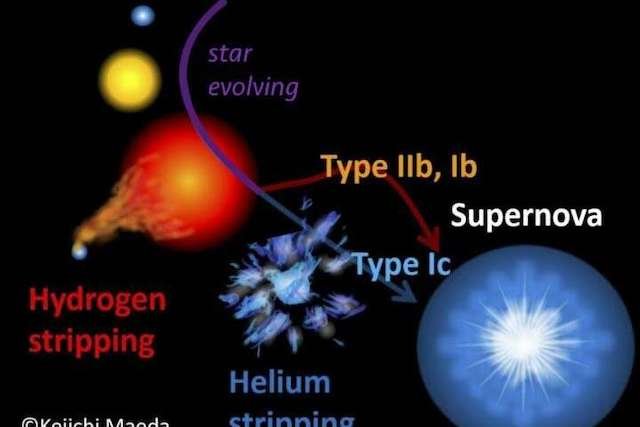
In a new study, researchers found some stars exploding as supernovae may release their hydrogen layers to their companion stars before the explosion.
The research was led by researchers at Kyoto University.
Previous studies have shown that many massive stars have a companion star. In a binary star system, the star can interact with the companion star during its evolution.
Research also has shown that stars over 8 times more massive than the sun end their lives in supernovae explosions. The composition of the star could influence its explosion.
When a star develops into a red supergiant star, its companion star may disrupt the outer layers of the supergiant star. The outer layers are full in hydrogen.
When a star has lost part or all hydrogen layers, the explosion can be seen as a type Ib or IIb supernova.
In a type Ic supernova, the star explodes after losing its helium layer due to the stellar winds.
The researchers found the binary interaction may remove the hydrogen layer of the supergiant star partially or completely.
Although the companion star plays a big role in the supernovae’s hydrogen layers, it does not have a significant role in what happens to the exploding star’s helium layer.
Instead, they suggest stellar winds play a big role in the star’s helium layer.
According to the researchers, stellar winds are massive streams of energetic particles from the star surface. They may remove the helium layer below the hydrogen layer.
The findings show the hybrid mechanism may help describe the evolution of massive stars.
The theory suggests that during its lifespan, the star may lose part of its mass both to its companion star due to interaction as well as because of stellar winds.
The team suggests that the understanding of massive star evolution is still far from complete. Future work is needed to gain a deeper understanding of the process.
One author of the study is postdoctoral researcher Hanindyo Kuncarayakti from the Department of Physics and Astronomy at the University of Kyoto in Finland and the Finnish Centre for Astronomy with ESO.
The study is published in Nature Astronomy.
Copyright © 2019 Knowridge Science Report. All rights reserved.



